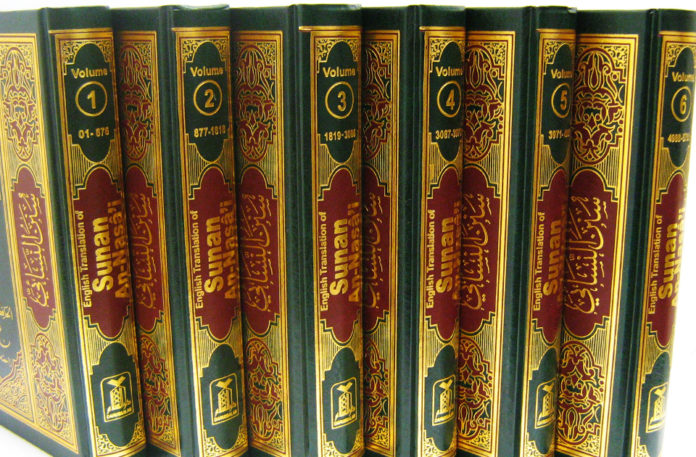Aḥmad ibn Shu`ayb ibn `Alī ibn Sīnān Abū `Abd ar-Raḥmān al-Nasā’ī (214 – 303 AH/ ca. 829 – 915 AD/CE), was born in the year 214 A.H in the famous city of Nasa, situated in Western Asia known at that time as Khurasan which was a famous centre for Islamic knowledge where many Ulama were situated and studies in hadith and fiqh was at its peak. He primarily attended the gatherings and circles of knowledge in his town where he specialized in his study of hadith. When he was 20 years old, he started traveling and made his first journey to Qutaibah. He covered the Arabian Peninsula seeking knowledge from the Ulama and Muhadditheen of Iraq, Kufa, Hijaz, Syria and Egypt . Finally he decided to settle in Egypt.
Memory, Piety, and other qualities:
He was a man full of taqwa and he possessed a photographic memory too. The famous scholar and commentator of the Holy Qur’an Al-Dhahabi would say narrating from his teachers that this Great Imam was the most knowledgeable in Egypt. The Great Imam would put on good clothing according to the Sunnah of our beloved Prophet Muhammad pbuh and would eat poultry everyday with nabeedh acting on the Sunnah so that he could worship Allah with ease. In fact it is narrated that the man would fast every other day which is classified in the hadith as the fast of Dawud (as) he would worship Allah continuously throughout the nights and teach Hadith throughout the day. The Imam would also perform Hajj nearly every year and would also take part in Jihad. He was a truthful man.
Teachers and Students:
Imam an-Nasa’i studied from many teachers, the famous ones are: Ishaq ibn Rahweh, Imam Abu Dawud Al-Sijistani (author of Sunan Abu Dawud) and Qutaibah ibn Saeed. After the Imam had decided to stay in Egypt he started to lecture, mostly narrating ahadith to the extent that he became famous by the title Hafidhul Hadeeth. Many people would attend his gatherings and many famous Great Scholars became his students and notably the most famous ones are:
Imam Abul Qasim Tabarani
Imam Abu Bakr Ahmed ibn Muhammad also known as Ibn as-Sunni.
Sheikh Ali, the son of the famous Muhaddith, Imam Tahawi.
It is also narrated that Imam Tahawi personally narrated from this Imam.
Muqallid or Mujtahid
Imam an-Nasa’i was a follower of the Shafi’i Fiqh according to many scholars. Some other scholars consider him to be a Hanbali and Sheikhul Islam ibn Taymiyyah has also stated this. It is likely that he was a Mujtahid more inclined towards the Hanbali Fiqh but many a time would differ from the Hanbali scholars.
His Works
The great Imam also left behind many beneficial works, many of which unfortunately are not published but we can without any doubt conclude from what we have understood that his knowledge and excellence is no less than that of Imam Bukhari and ibn Hazm.
These are a few of his famous works:
1. Sunan Al-Kubra
2. Sunan Al-Sughra/Mujtana/Al-Mujtaba (popular today as Sunan an-Nasa’i)
3. Amul Yawmi Wallaylah
4. Kitaby Dufai wal Matrookeen
5. Khasais Ali
6. Al-Jarhu wa Ta’adeel
His famous book known as Sunan al-Nasa’i which is taught around the world in every Islamic institute and which possesses a virtue of being one of the Kutub Sittah (the six books generally taught in hadith). In reality when the Imam had finished compiling Sunan Al-Kubra he presented to the governor of Ramalah so the governor asked him Is it all sahih? He replied in the negative, thus the governor suggested and requested that he compile another book and gather in there the Sahih Hadith. So then he did this and named his book Sunan Al-Sughra (the small Sunan) and Al-Mujtaba and Mujtana (both mean carefully chosen) and this is the Sunan which we know as Sunan An-Nasa’i. In this book he follows the footsteps of Imam Muslim and Imam al-Bukhari (R.A). Overall most of the ahadith are Sahih and where he narrates a weak narration he clearly clarifies the weakness. Thus it is 3rd in number in the Kutub Sittah after Bukhari and Muslim according to some Ulama’ because of its Sahih narrations. He clearly clarifies the hard words and brings different narrations for particular ahadith as Imam Muslim does.
His Death:
Controversies arose between the Khawarij (who cursed Ali and revered Muawiya) and the khutbas of Imam an-Nasa’i, he was tortured and forced to move from Palestine to Egypt. In Egypt his trials did not stop and he was persecuted further. From Egypt he intended to go to Makkah but as he arrived in Makkah he passed away at the age of 88 on Monday 13th of Safar 303 AH in the holy city near the Ka’ba and he was buried between Safa and Marwa. Ibn Hajr and adh-Dhahabi state that he passed away in Ramalah, Palestine during the journey to Makkah and the body was sent to Makkah and buried between Safaa and Marwa.
Footnote
Taken from sunnah.com
(NOTE: If you want to build a strong and powerful relationship with Allah, check out Islamia TV, where you can watch Islamic speakers from across the globe deliver inspiring and motivational courses. Learn more at www.islamia.tv.)





















